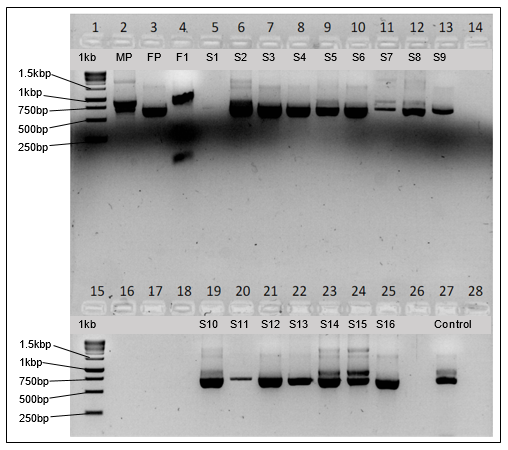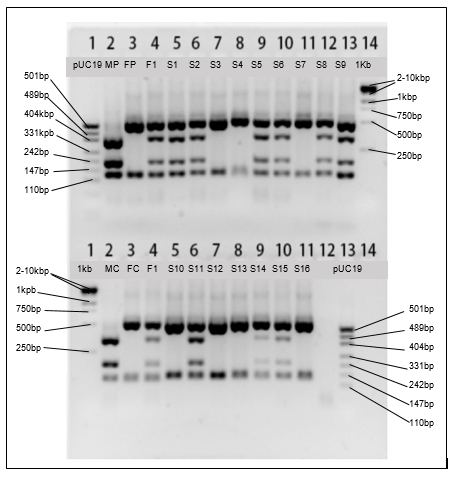Introduction
Bacterocera tryoni, a serious pest of diverse fruits and vegetables, belongs to the family of Tephritidae and is native to Australia, particularly the state of Queensland. It is an appropriate model insect that the study used to illustrate genetic linkage and mapping of visible and molecular markers of the white gene. According to Gilchrist et al. (2014), tephritid fruit flies live in colonies that permit sympatric speciation and the maintenance of pure strains. Moreover, B. tryoni flies are easy to manipulate to get desired hybrids because they have a flexible mating pattern that allows male back cross without the interference of crossing over during meiosis. Comparatively, B. tryoni has white recessive marks on its thorax, which are homologous to white eyes of Drosophila melanogaster. The mapping of the white gene on different chromosomes and microsatellite loci suggests the existence of a linkage to the visible white marks.
Gene mapping is essential to create a genetic linkage between the visible white marks and white gene in B. tryoni. In the experiment, male back cross enabled the identification and differentiation of the nature of linkage that exists between the white marks and the white gene. The presence of simple sequence repeats (SSRs) and single nucleotide polymorphisms (SNPs) in the white gene permits RFLP to generate fragments of different lengths. The targeted region of the white gene comprises of 680bp with conserved restriction site (GTAC) and polymorphic restriction site (GTWC) for Rsal. When digested with Rsal, the conserved restriction site in one allele (b) generates two fragments (550bp and 130bp), whereas both conserved and polymorphic restriction sites give three fragments (360bp, 190bp, and 130bp) in another allele (a). RFLP is a molecular marker that effectively differentiates the two alleles of the white gene and enhances the creation of the genetic linkage of white marks. Hence, the purpose of the laboratory report is to describe how amplification of the white gene, restriction fragment lengths, and association analysis lead to the formation of the genetic map that links it to white marks.
Methods
The parental cross was conducted between two stocks of flies to get the first generation progeny (F1). For white marks, male parent flies in one stock were homozygous wild-types with conserved and polymorphic restriction sites for Rsal (wm+/wm+ Ra /Ra), while female flies in another stock were homozygous mutants with a conserved restriction site for Rsal (wm/wm Rb/Rb). Subsequently, the male back cross was done and genotypes and phenotypes of the second generation progeny (G2) were recorded. The ratios of genotypes and phenotypes were determined and compared to expected ones in linked and unlinked genes.
Flies were sampled from parental, the first progeny, and the second progeny and their genomic DNA were isolated. Each demonstration group was assigned 20 samples of genomic DNA constituting of the male parent (MP), female parent (FP), first generation (F1), 16 second generations (G2), and negative control. The polymerase chain reaction (PCR) was done using a thermocycler to amplify the target region of the white gene in the isolated DNA samples of respective flies. The PCR master mix was prepared with the final concentration of 16.6mM [NH]SO4, 0.5mM dNTPs, 67mM Tris-HCl (pH 8), 3mM MgCl2, 0.45% Triton X-100, 0.2mg/ml gelatin, 12.5μM primer mix, and 0.35units/μl Taq polymerase. The amplification was done on a 25μl reaction volume comprising of 18μl, 2μl, 3μl, and 2μl of the master mix, primer mix, genomic DNA, and Taq polymerase, respectively.
The PCR reaction contents were mixed thoroughly and placed in a thermocycler for amplification. The thermocycler was set and the amplification process was allowed to run for about three hours. The PCR conditions were initial denaturation for 3 minutes at 94°C and final extension for 5 minutes at 72°C with cycling times of denaturation for 1 minute at 94°C, annealing for 1 minute at 60°C, and extension for 1 minute at 94°C. After completion of the amplification process, amplicons were removed and stored in a freezer at -20°C to preserve them for the next procedure.
The PCR product volume of 25μl for each sample was divided into two equal portions for genotypic analysis. One portion of the PCR product was digested with RSal for RFLP analysis, whereas the other portion was not digested. PCR products (12.5μl), 1.75 units/µl Rsal, sterile MQ water, and 10X restriction buffer with 100mM MgCl2, 500nM NaCl, 100mM Tris-HCl, and 100mM DTT were used to carry out restriction digest. The mixture of restriction digest (20μl) was prepared by adding 10μl of PCR product, 6μl of MQ water, 2μl of 10X buffer, and 2μl Rsal into a 1.5 ml sterile microfuge tubes for each sample. The digestion mixtures for all samples were incubated in a water bath set at 37°C for 1 hour.
Agarose gel electrophoresis was utilised to analyse DNA fragments obtained from the amplification of the white gene and digestion by Rsal. Gel electrophoresis apparatus constituting of gel tanks, video camera, power pack, UV filter, and UV transilluminator was set up in the laboratory. Moreover, 2% agarose, 1X sodium borate buffer, 25ng/μl pUC19/Hpall standard, and 25ng/μl 1kb ladder were prepared for electrophoresis. The DNA analysis was done by loading 20μl of digested PCR fragments, 12μl of undigested PCR fragments, positive control samples, and genomic standards, as illustrated in Tables 4 and 5 (Supplementary Section). The voltage of electrophoresis was set at 180 and allowed to run until the dye front reaches a considerable distance to allow separation of fragments. Ultimately, the gels were read using UV transilluminator and images were taken for the analysis, as indicated by Figures 1 and 2 (Supplementary Section).
Results
The estimated fragment sizes of undigested and digested amplicons were tabulated in Table 1 and Table 2, correspondingly. Comparison of the estimated and the expected band sizes indicates that the undigested fragments did not deviate significantly from 680bp. The estimated fragment sizes of the undigested amplicons ranged from about 600bp to 750bp.
Table 1. The estimated fragment sizes of undigested amplicons.
Table 2 shows that the estimated fragment sizes of digested amplicons were 550bp, 360bp, 190bp, and 130bp for heterozygous (RaRb), 550bp and 130bp or 360bp, 190bp, and 130bp for homozygous (RaRa or RbRb). These fragments are of the expected sizes based on restriction digest by Rsal.
Table 2. The estimated fragment sizes of digested amplicons.
The comparative tabulation (Table 3) depicts that phenotypes of white marks link to microsatellites loci of the white gene, Bt1 and Bt7 in chromosome 2, and Bt2 in chromosome 5. While white marks link to homozygous short alleles (SS) in the Bt1 and Bt7 loci, wild-type marks associate with homozygous long alleles (LL) in the same loci. In the Bt2 locus, homozygous long alleles (LL) link to homozygous white RFLP (RaRa), whereas homozygous short alleles (SS) link to homozygous white RFLP (RbRb) and heterozygous alleles (SL) in both Bt1 and Bt2 loci link heterogeneous white RFLP (RaRb).
Table 3. Phenotypes for white marks in the identified microsatellites and chromosomes.
Discussion
Genotypic ratios generated from the banding patterns of the digested and undigested amplicons showed that white marks of B. tryoni link to the white gene. Furthermore, comparison of the distribution of phenotypes and genotypes of white marks revealed that they link to Bt1and Bt7 loci of microsatellites in chromosome 2 and Bt5 locus in chromosome 2. Choo et al. (2017) established that the white gene comprises of seven exons that cover different chromosomes and have genetic linkages with white marks. The existence of numerous microsatellites in B. tryoni complicates mapping of the sequence of genes in the two identified chromosomes. In this view, an accurate mapping of the white gene and white marks requires the use of gene knockout and sequencing of target genes (Choo et al., 2017; Costain, Kannu & Bowdin 2018; Gilchrist et al. 2014). Gene knockout aids in linking genotypes to specific phenotypes, whereas sequencing allows identification of chromosome, microsatellite, and gene loci of the white gene.
A critical analysis of the results indicates that agarose gel electrophoresis did not give clear bands, making it difficult to estimate the sizes of fragments resolved. Dowdle et al. (2017) recommend lowering of voltage to 120, accurate loading of samples, and extended time for sufficient resolution of bands in the gel. Modern techniques that could complement RFLP in this study are sequence-tagged sites (STS), fluoresce in situ hybridisation (FISH), and bulk segregant analysis (BSA) (Jagannathan et al., 2017; Pool 2016; Saeed, Wang & Wang 2016). To enhance the understanding of B. tryoni, future research should consider exploring microsatellites and identifying their roles in the inheritance of the white gene, associated genes, and visible markers.
Conclusion
The report reveals that genetic and phenotypic ratios suggest that white marks and the white gene have close linkages based on their patterns of inheritance. Specifically, white marks and the white gene links to Bt1 and Bt7 loci of microsatellites in chromosome 2 and Bt2 locus in chromosome 5.
References
Choo, A, Crisp, P, Saint, R, O’Keefe, LV & Baxter, SW 2017, ‘CRISPR/Cas9‐mediated mutagenesis of the white gene in the tephritid pest Bactrocera tryoni’, Journal of Applied Entomology, vol. 142, no. 1-2, pp. 52-58.
Costain, G, Kannu, P & Bowdin, S 2018, ‘Genome-wide sequencing expands the phenotypic spectrum of EP300 variants’, European Journal of Medical Genetics, vol. 63, no. 3, pp. 125-129.
Dowdle, ME, Imboden, SB, Park, S, Ryder, SP & Sheets, MD 2017, ‘Horizontal gel electrophoresis for enhanced detection of protein-RNA complexes’, Journal of Visualised Experiments, vol. 1, no.125, pp. 1-4.
Gilchrist, AS, Shearman, DC, Frommer, M, Raphael, KA, Deshpande, NP, Wilkins, MR, Sherwin WB, Sved JA 2014, ‘The draft genome of the pest tephritid fruit fly Bactrocera tryoni: resources for the genomic analysis of hybridising species’, BMC Genomics, vol. 15, no. 1, pp. 15(1), 1-16.
Jagannathan, M, Warsinger-Pepe, N, Watase, GJ & Yamashita, YM 2017, ‘Comparative analysis of satellite DNA in the Drosophila melanogaster species complex’, Genes Genomes Genetics, vol. 7, no. 2, pp. 693-704.
Pool, JE 2016, ‘Genetic mapping by bulk segregant analysis in Drosophila: experimental design and simulation-based inference’, Genetics, vol. 204, no. 3, pp. 1295-1306.
Saeed, AF, Wang, R & Wang, S 2016, ‘Microsatellites in pursuit of microbial genome evolution’, Frontiers in Microbiology, vol. 6, no. 1462, pp. 1-15.
Supplementary Information
Table 4: Agarose gel loading schematic for PCR uncut DNA.

Table 5: Schematic representation of undigested amplicons loaded on gel.
